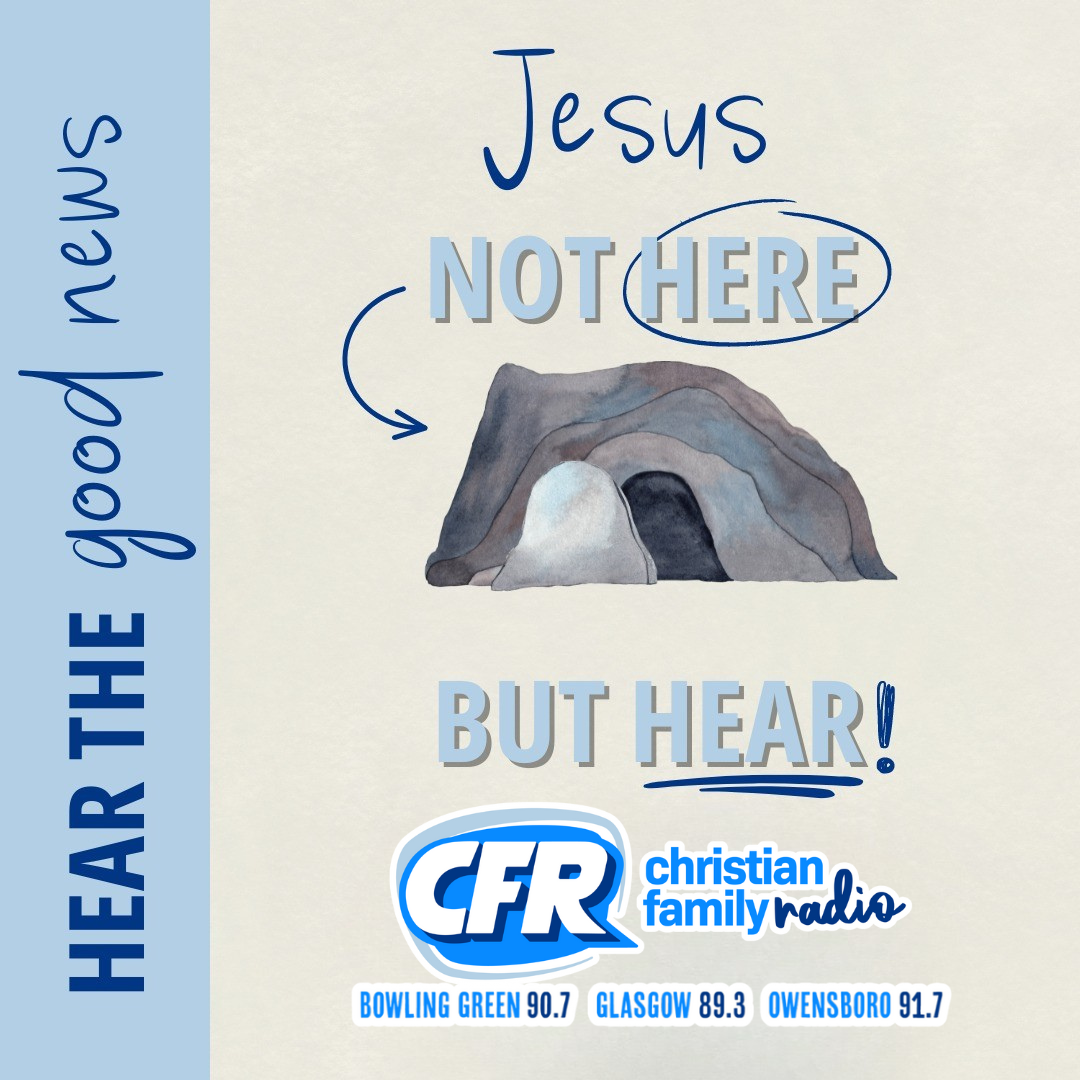Holy Week on CFR | April 14th-20th

Easter is the most significant holiday in the Christian calendar, commemorating the resurrection of Jesus Christ. It is a time of joy, reflection and renewal, marking the fulfillment of God’s promise of salvation. The story of Jesus' death & resurrection is good news for all people and CFR is celebrating with special music, programming, and devotions.
We invite you to listen, read, watch, and follow along with us each day leading up to Easter Sunday.
Monday, April 14th
Palm Sunday celebrates Jesus and his disciples arriving in Jerusalem to celebrate Passover after a long journey. Jesus’ arrival in the city is often referred to as the “triumphal entry.” And it was—the crowds cried out, “Praise the King who comes in the name of the Lord!” And they sang “Hosanna!” while throwing palm branches and coats on his path.
Why was Jesus given this royal treatment?
Israel’s prophets spoke about a king who would come to the holy city and bring justice and peace to Israel (Zech. 9:9). When the crowds see Jesus on the donkey, they seem to think that Jesus is God’s promised King, the long-awaited Messiah sent to rescue Israel and establish God’s Kingdom on Earth.
But Jesus wasn’t the king they were expecting. Many thought this king would honor the temple and its powerful leaders, but Jesus powerfully criticizes the temple system and predicts its collapse. Others hoped Jesus would lead a military revolt as previous “messiahs” had done, but Jesus rides in without armies or weapons or warhorses. He comes on a donkey filled with patient, peaceful, self-giving love. He shocks people further when he says that the Kingdom of God belongs not to the elite and powerful but to the poor and the outsider. God’s Kingdom is one where love reigns—love of God and others, including our enemies.
Tuesday, April 15th
Though the gospel accounts vary on the timeline of Holy Week events, Monday possibly included Jesus cursing the fig tree and exposing the temple system’s corruption (see Matt. 21:17-22; Mark 11:15-26; Luke 19:45-48). Both moments are symbolic sign-acts that declare God’s dissatisfaction with Israel’s most respected leaders. And the people were shocked by Jesus’ acts!
Imagine Jesus in the middle of a bustling market filled with the smell of livestock and smoke from the temple’s altar. He’s in the temple’s Court of the Gentiles, which is not supposed to be a marketplace. It’s the largest space on the temple mount, dedicated for non-Israelites to pray and worship. The temple leaders who disliked non-Israelites were happy to turn their prayer space into a busy market, so Jesus staged a prophetic protest.
Standing in the center of the courtyard, Jesus shouts words from Isaiah and Jeremiah, “My house will be called a house of prayer,” but you are making it into a “den of robbers” (cf. Isa. 56:7; Matt. 21:13, Jer. 7:11). Jesus is saying that the leaders are valuing themselves and their profits over their non-Israelite neighbors. Israel has been called to bless their neighbors (Gen. 12:1-3), and in the courtyard, Jesus observes just the opposite.
Wednesday, April 16th
By Tuesday, Jesus’ unwillingness to obey the religious elite had made him an enemy to Israel’s leaders. They challenge Jesus with their assumptions and doctrinal traditions, hoping to publicly prove that Jesus is a fraud—a criminal and a liar who is set on disrupting their control. But Jesus keeps telling the truth, showing the leaders how the mistake is their own. What irony! They’re mad at God for not being godly enough, according to their own judgment (see Matt. 21:23-27; Mark 11:27-33; Luke 20:1-8).
Jesus predicts that the Roman armies will one day surround Jerusalem and destroy the city and its temple, but his disciples struggle to understand this and ask him when it’s going to happen.
In a speech sometimes referred to as the Olivet Discourse, Jesus gives a few vague images of what’s to come. He predicts his death but also assures the disciples that his death will not be the end. He says he will resurrect and continue living after death, before eventually returning to fully establish his Kingdom on Earth. Jesus cautions the disciples against trusting people who say they know the signs of the end times. Those so-called “signs” (like natural disasters, wars, and rumors of conflict) are normal parts of the world being renewed. Instead of losing focus by getting wrapped up in that fear, Jesus urges his followers to remain focused on him and follow his loving way. Keep living into the Kingdom of God, he says, and don’t stop spreading Jesus’ good news to all people.
Thursday, April 17th
Jesus and his disciples are reclining around a knee-high table in a quiet upstairs room near the heart of Jerusalem. They’re enjoying good wine. Aromas of roasted lamb, herbs, and bread mix with the smoke of oil lamps, and everyone feels the uniqueness of the moment. As they share this Passover meal, each participant eats and drinks a story they belong to. In a way, this ritual is like transcending time to enter into the first Passover moment in Egypt while bringing the story into their present world. And during this sacred meal, Jesus offers a new mandate—a new command.
We often celebrate this day as Maundy Thursday, employing the Latin term mandatum, which means “mandate” or “commandment.” Jesus says, “A new commandment I give to you, that you love one another; just as I have loved you, you also are to love one another” (John 13:34). This is a new chapter in Israel’s long story, and he invites them to eat and drink this new chapter in the story along with the old. Jesus will instruct his followers to continue remembering him when they have meals like this, which includes remembering his forgiving, nonviolent way of love toward everyone in the world. We are made to love, forgive, and bless others like Jesus does, and we eat and drink his story every time we participate in remembrance celebrations like communion meals, Lord’s Supper celebrations, the Eucharist, and sharing meals with others. We are joining him in this upper room moment as he joins us in our own.
To love one another in Jesus’ way means a willingness to give our own lives in love for all—something Jesus demonstrates the next day, Good Friday.
Friday, April 18th
The one day during Holy Week that we call "good" is also the darkest, most painful day—Good Friday. So what is it that’s good about this day?
After sharing a Passover meal with his friends, Jesus takes them for a short walk across the Kidron Valley, into a garden. He enters a deep, excruciating time of prayer there and asks God to spare him of his fate—Jesus knows he will soon be murdered.
In the early hours of the night, Judas uses what should be an expression of love—a kiss—to betray Jesus. He tells Roman soldiers that the one he kisses is the one they are looking for, and after he does it, Jesus is taken into custody. Powerful men use deception and coercion to find Jesus guilty and condemn him to death. But Jesus loves each of them, even though they wish to harm him, and rather than fighting back, he remains silent when accused.
Jesus is publicly tortured and mocked as people spit on him and beat him bloody. He is stripped naked and led away to be crucified. He endures beatings, scourging, and gut-wrenching humiliation. Outside the city, his accusers nail him to a cross where he eventually dies. Before dying, he prays for the people who are killing him. “Father, forgive them,” he says, “for they know not what they do” (Luke 23:34). God’s unbreakable love for every human being, including his enemies, shines bright on this dark, deadly Good Friday.
Saturday, April 19th
Holy Saturday is marked by darkness and waiting—waiting in grief, in hope, and with unanswered questions.
Now that Jesus has been killed, the chief priests and Pharisees want Jesus’ tomb secured for at least three days. The Roman leader, Pontius Pilate, commands his guards to protect the tomb from anyone wishing to enter. They also rolled a stone in front of the tomb’s entrance to seal it, meaning they squished a lump of clay (or some soft substance) into a seam that would break if the stone was tampered with. They press an imperial Roman symbol into the clay, so that anyone looking to disrupt the seal would face the consequences of the brutal Roman government.
Imagine you are an early follower of Jesus. You have been waiting for the promised messiah your entire life. And then you heard the word of Jesus—you have spoken with him and seen his miracles, and you have come to believe that he is filled with the unending, indestructible power of God because he is the promised Messiah! But now he’s dead, crucified, murdered. You heard him talk about dying and being raised back into life, but how is that even possible? Was he just another magician? Another wandering sage peddling false promises? Your newly kindled hope in the messiah would have been snuffed out with Jesus’ execution.
Holy Saturday invites us into the experience of darkness, into the questions and grief that so often accompany this life. Where is God? Why do we experience so much pain? We thought Jesus came to rescue us, but what now?
Today, we sit in the painful darkness of Holy Saturday and find rest through knowing that, in the darkness of life, God is alive and working. In deep sorrow, God is still there. In our waiting, God has not forgotten us. He is loving us and working in his ways to restore life to each of us.
The sealed stone will not be able to hold Jesus in place. Death is not the end.
Sunday, April 20th
Death is not the end of the story for Jesus of Nazareth. As the firstborn of new creation (Col. 1:15, 18) and the heir of all things (Heb.1:2), he is showing humanity that death is not the end of our story either. It’s a brutal and mysterious part of our story, but in the light of Christ, we can believe that our life does not end in earthly death. God’s love carries us through, and death loses its sting in the face of Jesus’ resurrection promise. This is the indestructible life we celebrate on Easter Sunday, the life of Jesus!
Three days after Jesus’ execution, two women from among Jesus’ disciples find out that the tomb’s stone has been moved—the seal is broken, and Jesus’ body is gone. An angelic man says Jesus has risen, and he urges the women to tell the other disciples. Jesus is alive and heading north, and he plans to meet his disciples in Galilee.
Jesus meets with his followers, showing them his wounds and letting them touch his resurrected body. According to Luke’s version of the story, when Jesus first sees the disciples, he asks them if they have any leftovers to share. They give him some fish, and he chats with them over a meal (Luke 24:41-43). Jesus passed through death and returned to life as a walking, talking, living human being who was hungry for some leftovers—he is the firstborn of humanity in the new creation. And he tells his disciples that he’s going to give them the same divine power that sustains him, so they can go out and share the good news of resurrection and the unending love of God’s Kingdom with people throughout the world.
Jesus sends the disciples out to all families of the Earth with this good news. Everyone can join Jesus’ Kingdom by turning away from their fear of death and turning toward his love and following his way of life. On Easter Sunday, followers of Jesus celebrate with joy! Jesus has risen, and his new creation has begun. Happy Easter!
